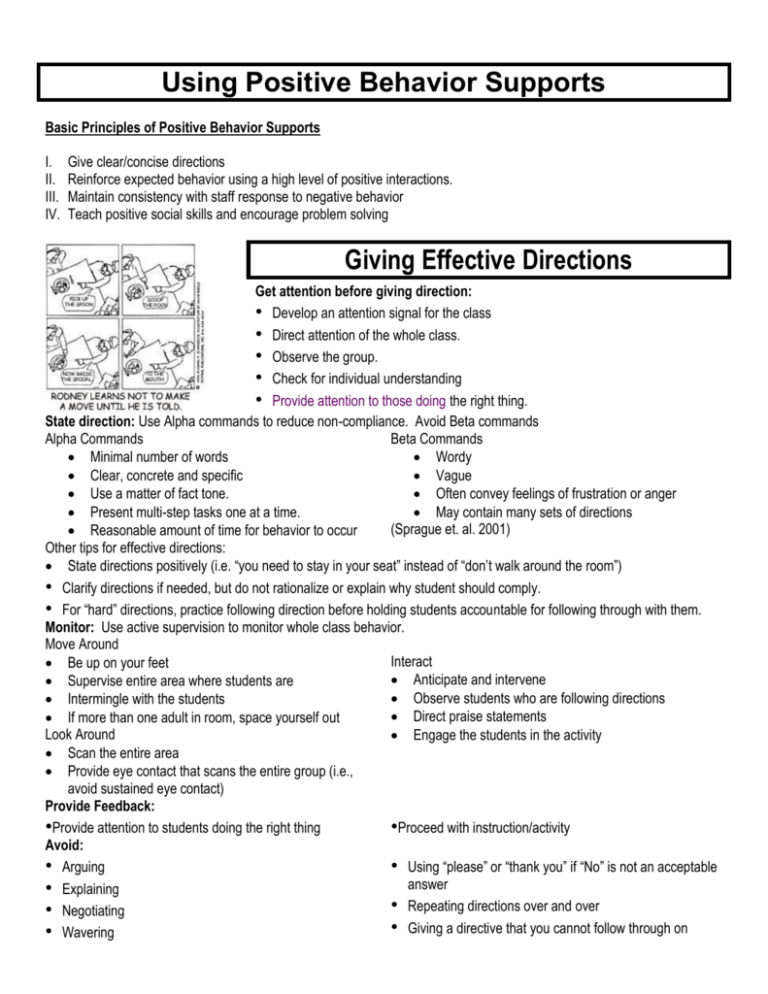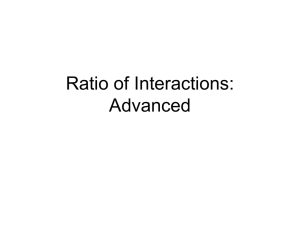Using Positive Behavior Supports
advertisement

Using Positive Behavior Supports Basic Principles of Positive Behavior Supports I. II. III. IV. Give clear/concise directions Reinforce expected behavior using a high level of positive interactions. Maintain consistency with staff response to negative behavior Teach positive social skills and encourage problem solving Giving Effective Directions Get attention before giving direction: • Develop an attention signal for the class • Direct attention of the whole class. • Observe the group. • Check for individual understanding • Provide attention to those doing the right thing. State direction: Use Alpha commands to reduce non-compliance. Avoid Beta commands Alpha Commands Beta Commands Minimal number of words Wordy Clear, concrete and specific Vague Use a matter of fact tone. Often convey feelings of frustration or anger Present multi-step tasks one at a time. May contain many sets of directions (Sprague et. al. 2001) Reasonable amount of time for behavior to occur Other tips for effective directions: State directions positively (i.e. “you need to stay in your seat” instead of “don’t walk around the room”) • Clarify directions if needed, but do not rationalize or explain why student should comply. • For “hard” directions, practice following direction before holding students accountable for following through with them. Monitor: Use active supervision to monitor whole class behavior. Move Around Interact Be up on your feet Anticipate and intervene Supervise entire area where students are Observe students who are following directions Intermingle with the students Direct praise statements If more than one adult in room, space yourself out Look Around Engage the students in the activity Scan the entire area Provide eye contact that scans the entire group (i.e., avoid sustained eye contact) Provide Feedback: •Provide attention to students doing the right thing •Proceed with instruction/activity Avoid: • Arguing • Using “please” or “thank you” if “No” is not an acceptable answer • Explaining • Repeating directions over and over • Negotiating • Giving a directive that you cannot follow through on • Wavering Reinforcing Expected Behavior 4:1 Rule Research has shown that positive reinforcement is more effective in shaping behavior than punishment. Ideally, staff should use at least 4 positive interactions for every negative or corrective interaction with each child. Establish rapport It is important to establish rapport with students because it increases the likelihood of them following directions. Ways to establish rapport: • Greet students. • Interact with students. • Pair yourself with reinforcing items. • Catch them when they are doing the right thing. Use positive reinforcement to shape behavior Reinforcement defined: Something that increases a desired behavior. Payoffs are not considered reinforcers if they do not increase desired behavior. The value of reinforcers is always changing, so they need to change often. Rules of reinforcement: Behaviors that are reinforced will be repeated. Behaviors that are maintained are reinforced. Find out what motivates specific students: To be considered a reinforcer, a student pay-off must be motivating to the student. Guidelines for Shaping Behavior: Provide opportunities for success. Start praising behavior that approaches goal (i.e. if goal is to sit still in seat, start with praising just for being in seat). Use four positive statements for every negative or corrective statement. To be specific with your praise, make sure that you tell them what they are doing well. For example, instead of saying “Good job!”, you could say, “Nice job putting your materials away.” Find some statements that work for you. If praise statements feel unnatural at the beginning, try simply acknowledging when students follow directions, e.g. “You are following directions by putting the materials away.” Using Planned Ignoring Planned ignoring is a strategy designed to change student behavior. It is an effective technique for eliminating problem behaviors when it is paired with positive interactions (4:1). Planned ignoring will not be effective if the majority of the teacher-student interactions are negative. With planned ignoring, you reduce/eliminate the attention a student receives for engaging in a misbehavior, while concurrently giving the student frequent attention when s/he is not engaged in misbehavior. The goal is for the student to learn that using misbehavior to get attention is ineffective, but that behaving responsibly results in frequent, positive attention. Behaviors to Ignore: Petty low-level misbehaviors directed to get the teacher’s attention: Calling out Excessive helplessness Tattling Minor disruptions Behaviors Not to Ignore: Misbehaviors supported by peers Misbehaviors that have a history of escalating Misbehaviors that are dangerous, threatening, or unsafe Automatically reinforcing behaviors (e.g., Self-stimulating behaviors) Behaviors that cause a “problem” in a public place Steps to Planned Ignoring Ahead of time: Identify the behaviors that you WILL and WILL NOT ignore Determine whether the behavior is acceptable or whether the problem is with the frequency or duration of the behavior. Has the desired behavior been taught and practiced? Is the misbehavior one that has a history of accessing more staff attention than the desired behavior? The more defined these behaviors are, the greater the likelihood that you will be consistent. You won’t be as likely influenced by “how you feel at the time.” Did you know that your “good days” when you are feeling relaxed and refreshed are the days that you are more likely to be inconsistent? Identify the behaviors you will REINFORCE When Misbehaviors Occur: Continue doing what you are doing…TEACH! Provide positive feedback to the students doing the RIGHT THING. This helps you and your students focus on the desirable behavior. Do NOT state that you are ignoring – “I am ignoring you now,” shrug, sigh. Be consistent. Intermittent ignoring is worse than not ignoring When the misbehavior stops, give the student attention. Provide frequent attention with the student when s/he is not misbehaving (4:1) … PRAISE SPECIFICALLY. PRAISE OFTEN. Specific Response Sequence The specific response sequence was designed to maintain consistency with staff response to negative behaviors that can not or should not be ignored. Remember to use a calm, flat tone of voice when giving directions. If a student is compliant, praise and reinforce their positive behavior. The following steps are used when a student is defiant or disruptive. If the student is unsafe, proceed directly to the time out room, or remove from class. When giving a specific request, wait 5-10 seconds then: Redirect if noncompliant. Say “It’s not time for that now, you need to ___,” wait for 5-10 seconds. The student should: 1. Stop 2. Think about what s/he is doing. 3. Decide/ask what s/he should be doing and do it. If the student continues to be noncompliant, say “<>* take Two,” wait for 5-10 seconds. The student should: 1. Walk to a quiet area 2. Take deep breaths and relax/calm down. 3. When s/he is calm, say, “I’m ready to follow directions now.” 4. Go back to assigned area. If the student continues to be noncompliant, say “<> Take a think time,” wait for 5-10 seconds. The student should: 1. Sit with his/her hands folded, head forward, no talking 2. Wait for the next direction. 3. Follow teacher’s direction If the student continues to be noncompliant, say “<> take a time out,” wait for 5-10 seconds. The student should: 1. Walk to the time out area. 2. Stand or sit for 5 minutes quietly. 3. When the teacher tells her/him to, return to assigned area and follow directions. If a student is outside of the SLC classroom, they may be removed from class and sent back to the SLC for continued noncompliance. * <> = student name Crisis Development Model What is the CPI Crisis Development Model? When a student is agitated or escalating, staff response can impact whether the situation is diffused, or turns potentially unsafe. The CPI Crisis Development Model is based on the four stages of crisis development and staff responses designed to deescalate the behavior, and prevent unsafe acting out. Remember to maintain rational detachment by controlling your own behavior, and not taking the acting-out behavior personally. Crisis Development/ Behavior Levels Anxiety Staff Attitudes/Approaches Supportive A noticeable increase or change in behavior. e.g. fidgeting, talking a lot etc. An empathic non-judgmental approach attempting to alleviate anxiety. Defensive Directive The beginning stage of loss of rationality. e.g. insulting, verbal attacks, etc. Setting Limits that are 1) Clear & Simple, 2) Reasonable & 3) Enforceable Acting-Out Nonviolent Physical Crisis Intervention Total loss of control, which often results in a physical acting out episode. May be danger to self and others. Safe, nonharmful and restraint used only as a last resort when the student is a danger to self and others. Tension Reduction Therapeutic Rapport The decrease in physical & emotional energy that occurs after a person has acted out, characterized by the regaining of rationality Attempt to reestablish communication with the student. Why should we use the CPI Crisis Development Model? 1. It helps us to intervene early and appropriately. 2. It helps us to avoid over or under reacting. 3. It helps us to avert crisis. Nonverbal and Paraverbal Communication Your nonverbal communication can have a significant influence on whether a student escalates or deescalates. Be sure to consider the message your voice and body sends along with the words you use. Nonverbal Behavior Proxemics (Personal Space) Individual personal space varies from one person to another depending on the person approaching & context of situation. In North America, it is approximately 1 ½ to 3 feet. Factors that influence personal space include gender, appearance, culture, previous experiences, age, emotional state, environment Kinesics (Body Language) Includes facial expressions, gestures, posture and movements. Staff kinesic behavior can serve to escalate or de-escalate a given situation. The CPI Supportive Stance The CPI Supportive Stance is standing to the side of the student just out of arms reach (see diagram). Reasons for using the stance: Respects client’s personal space. Non-threatening, non-challenging, offers an escape route. Contributes to staff’s personal safety if attacked Paraverbal Communication Paraverbal Communication is the link between verbal and nonverbal communication. It is how we say what we say. There are 3 main aspects of your voice to consider when talking to students: Do… 1. Tone 2. Volume 3. Cadence use a calm, neutral tone of voice. Avoid negativity, sarcasm, impatience and condescension. use a reasonable volume for distance and speaking too loudly or too softly. situation. use an even rate and rhythm of delivery. speaking too slowly or too quickly. Using the STAR Model The STAR model offers steps for students to stop and think before acting. It gives them the opportunity to problem solve solutions instead of acting on impulse. Encourage students to use calming strategies when needed, and help them use the problem solving wheel. STAR Stop Think Act Review Take enough time to make a good choice. Use calming strategies if needed Identify the problem Decide how you feel about the problem Think of choices that would be safe, respectful and responsible. (use problem solving wheel) Consider what might happen if you make each choice. Act out your best choice; or talk about it with someone who can help. Ask yourself, “Did my action help me reach my goal?” or “Was my choice safe, respectful and responsible?” Explain how to prevent the problem in the future Calming Strategies Problem Solving Wheel 1, 2…10 Deep breaths Count to 10 Use a fidget Find a quiet place Walk Exercise Listen to music Write or draw Read





